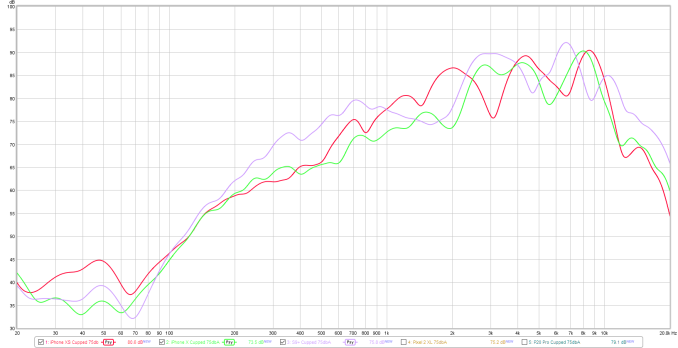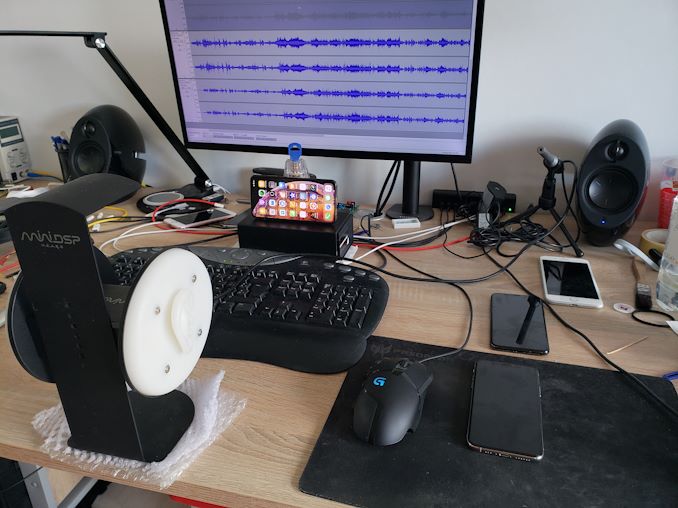The iPhone XS & XS Max Review: Unveiling the Silicon Secrets
by Andrei Frumusanu on October 5, 2018 8:00 AM EST- Posted in
- Mobile
- Apple
- Smartphones
- iPhone XS
- iPhone XS Max
Camera Video Recording
In terms of video recording, the iPhone XS promises an improved dynamic range in modes up to 30fps. What this likely means is that the phone’s able to capture in HDR mode in the 30fps modes, doing the same kind of processing we also see in SmartHDR still pictures.
Also something I’ve dreaded on iPhones for years; the new iPhone XS finally introduces stereo audio recording. Why it took Apple such a long time to finally introduce stereo recording is something that boggles the mind, but, let’s not complain, as we now finally have it on the new generation.
iPhone XS: iPhone X:
Comparing the iPhone XS video to the iPhone X, there’s one thing that is immediately very evident: the new XS is able to produce much better image stabilisation than last year’s flagship. Indeed, it looks like Apple vastly improved the OIS/EIS on the new phones, as the wobble that happens when walking is gone on the XS.
Audio recording finally is up to par, and we can hear the wind and rustling leaves of the trees around us. I think Apple might still have to work a bit on the wind noise cancellation, as in some parts the audio sounded as if it was inside a tube.
In terms of image quality, Apple’s claims of the improved dynamic range are very much verified. The phone showcases a lot more brought down highlights in the scene, and in darker areas, show better shadows. It’s unfortunate that this is limited only to the 30fps modes, but it’s understandable.
Switching over from the main lens to the telephoto lens happens relatively fast, although with a short exposure flash and a slight delay on the first zoom. 4K60 recording doesn’t allow for the use of the telephoto lens.
All in all, the video recording quality of the new iPhone XS is massively improved in all areas of stabilisation, picture quality, and audio. 4K30 recording on the XS is probably the best I’ve seen on any smartphone – a definitive applause to Apple for the improvements here.
Speaker Evaluation
Apple claimed to have improved the speaker audio quality on the new iPhone XS, allowing for more stereo separation and filling sound. I had introduced a new speaker evaluation method a few months ago because this year’s efforts by smartphone vendors to improve speaker quality has been very pronounced, and I wanted to have a way to objectively convey these improvements.
Starting off with speaker loudness, we’re measuring the phones at maximum volume, both in one-hand portrait mode, as well as two-handed mode where the palms are cupped towards the user. These two use-cases are what I find myself most often using the phone’s speakers in, so hopefully that also represents how most users use it as well, please let me know otherwise!

Using a pink noise signal, the iPhone XS pretty much falls into line with the results of the iPhone X, coming in at a very loud 82.8dBA in portrait mode and 87.6dbA in two-handed mode. Apple’s sound directionality on the iPhone X and XS is among the best, most likely due to the fact that the stereo earpiece is among the loudest of current generation smartphones.
Measuring the frequency response of the speakers, we see the iPhone XS closely following the measurement of the iPhone X, however there’s a major difference in the mid-range where the XS is around 5dB louder, raising instrumental frequencies and voices. This difference is what I think Apple is referring to when talking about better “fullness”, as it is evident when playing back media.
To better demonstrate the difference between the phones, I’ve attempted to capture them with a binaural microphone setup. Now I know my environment isn’t perfect as I don’t have the necessary sound dampening equipment, but I hope it does serve as an overall adequate A/B comparison between the phones. I’ve tried to calibrate the sound as much as possible recorded by the setup to a flat frequency response, although I’m sure there are improvements to be made. As a comparison, I also included calibrated speakers as a baseline to get an idea of the microphone setup.
The audio is meant to be listened to with headphones, or even better with IEMs, as this will give the intended playback of the binaural recording.
The iPhone XS’ improvements in the mid-range are quite evident as voices sound deeper and more pronounced on the new phone. Stereo separation is also quite good – resulting in a filling audio experience.
I included the S9+ and G7 as comparison devices. Samsung still does a significantly better job at the low-mid ranges which gives the phone more overall presence than the iPhones, also has an advantage in the very high frequencies giving more clarity, however the new iPhone’s XS strength point in the mid-ranges is the S9’s weakness, and vocals sound a lot less present than on the XS.
As for the G7, I just wanted to showcase a mono speaker device, and just how huge the audio difference is. Unfortunately the G7, even though it promises to have a good speaker, fails in practice.












253 Comments
View All Comments
Andrei Frumusanu - Friday, October 5, 2018 - link
Pixels and Mate 20 are next in line.name99 - Friday, October 5, 2018 - link
Hi Andrei,A few comments/questions.
- the detailed Vortex and GPU die shots seem to bear no resemblance to the full SoC die shot. I cannot figure out the relationship no matter how I try to twist and reflect...
Because I can't place them, I can't see the physical relationship of the "new A10 cache" to the rest of the SoC. If it's TIGHTLY coupled to one core, one possibility is value prediction? Another suggested idea that requires a fair bit of storage is instruction criticality tracking.
If it's loosely coupled to both cores, one possibility is it's a central repository for prefetch? Some sort of total prefetching engine that knows the usage history of the L1s AND L2s and is performing not just fancy prefetch (at both L1s and L2s) but additional related services like dead block prediction or drowsiness prediction?
Andrei Frumusanu - Friday, October 5, 2018 - link
The Vortex and GPU are just crops of the die shot at the top of the page. The Vortex shot is the bottom core rotated 90° counter-clockwise, and the GPU core is either top left or bottom right core, again rotated 90° ccw so that I could have them laid out horizontally.The "A10 cache" has no relationship with the SoC, it's part of the front-end.
name99 - Friday, October 5, 2018 - link
OK, I got ya. Thanks for the clarification. I agree, no obvious connection to L2 and the rest of the SoC. So value prediction or instruction criticality? VP mostly makes sense for loads, so we'd expect it near LS, but criticality makes sense near the front end. It's certainly something I'm partial to, though it's been mostly ignored in the literature compared to other topics. I agree it's a long shot, but, like you said, what else is that block for?name99 - Friday, October 5, 2018 - link
"The benchmark is characterised by being instruction store limited – again part of the Vortex µarch that I saw a great improvement in."Can you clarify this? There are multiple possible improvements.
- You state that A12 supports 2-wide store. The impression I got was that as of A11, Apple supported the fairly tradition 2-wide load/1-wide store per cycle. Is your contention that even as of A11, 2 stores/cycle were possible? Is there perhaps an improvement here along the lines of: previously the CPU could sustain 3 LS ops/cycle (pick a combination from up to 2 loads and up to 2 stores) and now it can sustain 4 LS ops/cycle?
- Alternatively, are the stores (and loads) wider? As of A11, the width of one path to the L1 cache was 128 bits wide. It was for this reason that bulk loads and stores could run as fast using pair load-store integer as using vector load stores (and there was no improvement in using the multi-vector load-stores). When I spoke to some Apple folks about this, the impression I got was that they were doing fancy gathering in the load store buffers before the cache, and so there was no "instruction" advantage to using vector load/stores, whatever instruction sequence you ran, it would as aggressively and as wide as possible gather before hitting the cache. So if the LS queue is now gathering to 256 bits wide, that's going to give you double the LS bandwidth (of course for appropriately written, very dense back to back load/stores).
- alternatively do you simply mean that non-aligned load/stores are handled better (eg LS that crossed cache lines were formerly expensive and now are not)? You'd hope that code doesn't do much of these, but nothing about C-code horrors surprises me any more...
BTW, it's hard to find exactly comparable numbers, but
https://www.anandtech.com/show/11544/intel-skylake...
shows the performance of a range of different server class CPUs on SPEC2006 INT, compiled under much the same conditions. A12 is, ballpark, about at the level of Skylake-SP at 3.8 to 4GHz...
(Presumably Skylake would do a lot better in *some* FP bcs of AVX512, but FP results aren't available.) This gives insight across a wider range of x86 servers than the link Andrei provided.
The ideal would be to have SPEC2006 compiled using XCode for say the newest iMac and iMac Pro, and (for mobile space) MacBook Pro...
Andrei Frumusanu - Friday, October 5, 2018 - link
> Is your contention that even as of A11, 2 stores/cycle were possible?Yes.
> - Alternatively, are the stores (and loads) wider?
Didn't verify, and very unlikely.
> - alternatively do you simply mean that non-aligned load/stores are handled better
Yes.
remedo - Friday, October 5, 2018 - link
Can you please review the massive NPU? It seems like NPU deserves a lot more attention given the industry trend.Andrei Frumusanu - Friday, October 5, 2018 - link
I don't have any good way to test it at the moment.Ansamor - Friday, October 5, 2018 - link
Aren't these (https://itunes.apple.com/es/app/aimark/id137796825... tests cross-platform or comparable with the ones of Master Lu? I remember that you used it to compare the Kirin 970 against the Qualcomm DSP.Andrei Frumusanu - Friday, October 5, 2018 - link
Wasn't aware it was available on iOS, I'll look into it.